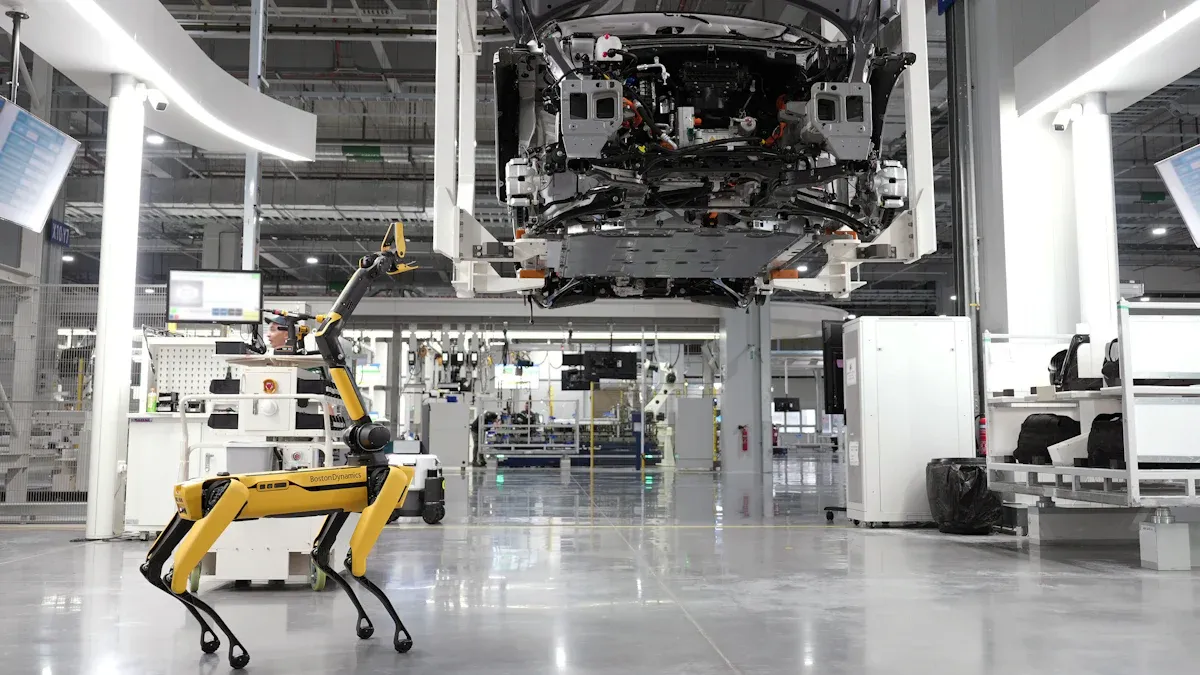Supply Chain Localization: Automakers’ Strategic Response to Trump’s Trade Policies

Trump’s trade policies have shaken the automotive industry, forcing manufacturers to rethink their global supply chains. Tariffs disrupted sourcing strategies, with 67% of manufacturers redesigning networks and supplier diversification rising by 42%. Supply chain localization has emerged as a vital strategy, but how are automakers adapting, and what does this mean for the industry?
Key Takeaways
Making supply chains local helps carmakers avoid global problems. Building things near buyers saves money and works better.
Using many suppliers is key to staying strong. Carmakers depend less on one area, making them flexible and safer.
Spending on local factories and tools boosts new ideas. Carmakers improve methods and find eco-friendly ways, helping them grow over time.
Trump’s Trade Policies and Their Impact on Automakers
Key Features of Trump’s Trade Policies
Trump’s trade policies introduced significant changes to global trade dynamics, particularly for automakers. The administration imposed tariffs on steel and aluminum imports, which are essential materials for vehicle production. These tariffs, set at 25% for goods from Canada and Mexico and 20% for Chinese imports, aimed to protect domestic industries but created ripple effects across the automotive sector.
The "reciprocal tariffs" policy added another layer of complexity. This policy matched U.S. import duties to those imposed by trading partners, leading to higher costs for automakers sourcing components internationally. For instance, while the U.S. previously levied a 2.5% tariff on EU vehicles, the reciprocal tariffs raised this to 10%, mirroring EU rates. Such measures disrupted long-standing trade relationships and forced automakers to rethink their supply chain strategies.
Tariffs and Their Effect on Automotive Supply Chains
The tariffs significantly increased production costs for automakers. Steel and aluminum tariffs alone cost U.S. light vehicle manufacturers nearly $500 million annually. These higher input costs led to reduced production and longer lead times. Smaller manufacturers faced even greater challenges, with margin reductions exceeding 8 percentage points.
Logistical costs also skyrocketed. Container rates surged from $2,000 to $20,000 per container, adding financial strain. Automakers like BMW absorbed these costs, which squeezed profit margins and limited investments in research and development. Meanwhile, price increases of 15-20% on components caused an 8-12% drop in demand, complicating supply chain planning.
The Role of USMCA in Supply Chain Localization
The United States-Mexico-Canada Agreement (USMCA) played a pivotal role in promoting supply chain localization. It introduced upgraded rules of origin, requiring automakers to source more materials from North America. The agreement also raised regional value content requirements and tied labor costs to production processes, incentivizing manufacturers to invest in U.S. facilities.
These changes made Mexico a competitive hub for North American production. By meeting regional content requirements, automakers reduced landed costs for components, enhancing efficiency. The USMCA’s focus on localized production aligns with the broader industry trend of supply chain localization, helping automakers mitigate tariff-related risks.
Supply Chain Localization Strategies in the Automotive Industry

Localized Production and Assembly
Automakers are increasingly shifting production closer to their target markets. This strategy minimizes the risks associated with global disruptions and reduces dependency on long-distance logistics. For example, Mexico has become a key hub for North American supply networks due to its proximity and cost advantages. By nearshoring production, companies can better meet regional content requirements, such as those outlined in the USMCA, while also cutting transportation costs.
Localized production also enhances resilience. Companies investing in digital technologies, like predictive demand forecasting, can adapt quickly to market changes. A shift from "just in time" to "just in case" manufacturing ensures that production lines remain operational even during supply chain hiccups. Japanese automakers learned this lesson after the 2011 tsunami, which disrupted centralized production. Today, they focus on distributed networks to avoid similar setbacks.
Realignment of Supplier Networks
Realigning supplier networks has become a cornerstone of supply chain localization. Automakers are diversifying their suppliers to reduce reliance on single regions. For instance, reliance on Chinese components has decreased by 35%, while sourcing from Mexico has risen by 28%. This diversification not only mitigates risks but also enhances operational efficiency.
A recent study of over 200 manufacturing executives highlighted four key strategies for supplier management: strengthening existing relationships, engaging multiple suppliers, using digital tools for visibility, and balancing efficiency with resilience. While redundancy may lower margins, it significantly boosts agility. Automakers are now better equipped to handle disruptions without compromising production schedules.
Inventory Buffering and Risk Mitigation
Inventory buffering plays a critical role in managing supply chain uncertainties. By maintaining extra stock of essential components, automakers create a safety net against unexpected shortages or delays. This approach proved invaluable during the recent tariff hikes, as companies could continue production without interruptions.
Balancing efficiency and resilience is crucial. While efficiency focuses on cost reduction, resilience ensures adaptability during crises. For example, maintaining safety stock of raw materials or finished goods helps firms navigate demand spikes or supply shortages. Additionally, capacity management—like adding shifts or contracting extra suppliers—provides flexibility to meet sudden demand increases. These strategies collectively strengthen supply chain localization efforts, ensuring smoother operations in uncertain times.
Implications of Supply Chain Localization for the Automotive Industry
Impact on Vehicle Prices and Consumer Behavior
Supply chain localization is reshaping how automakers price their vehicles and how consumers respond. By producing more components domestically, manufacturers reduce their reliance on costly imports. However, this shift often increases production costs due to higher labor expenses in regions like North America. For instance, the Inflation Reduction Act of 2022 offers tax credits of up to $7,500 for electric vehicles made in North America. While this incentivizes domestic production, it also raises questions about affordability for consumers.
Higher production costs often lead to increased vehicle prices. This can influence consumer behavior, as buyers may delay purchases or opt for used vehicles instead. Companies like Walmart have successfully tailored their strategies to local preferences, boosting sales. On the other hand, Target’s failure to understand local markets resulted in significant losses. These examples highlight the importance of aligning supply chain strategies with consumer expectations.
Changes in Market Dynamics and Competition
Localized supply chains are transforming market dynamics. Automakers are moving production closer to key markets to reduce risks and improve responsiveness. This shift is particularly evident in the automotive and electronics sectors, where disruptions like pandemics and geopolitical conflicts have exposed vulnerabilities in global supply chains.
Companies are adopting digital technologies, such as AI and IoT, to monitor supply chains in real time.
Manufacturers are relocating production from Asia to North America or Europe to shorten delivery times.
Localized strategies enhance flexibility and reduce dependency on single regions.
These changes are intensifying competition. Automakers with agile supply chains and advanced technologies are gaining an edge, while those slow to adapt risk losing market share.
Opportunities for Innovation in Local Manufacturing
Supply chain localization opens doors for innovation in manufacturing. Automakers are exploring new ways to optimize production and reduce waste. For example, some companies are focusing on battery circularity, recycling and repurposing electric vehicle batteries to create sustainable solutions. This not only reduces environmental impact but also lowers costs.
Additionally, local manufacturing encourages the development of advanced technologies. The CHIPS and Science Act, which allocates $54 billion to boost domestic semiconductor production, supports this trend. By investing in local facilities, automakers can enhance their technological capabilities and strengthen their supply chains. These innovations position the industry for long-term growth and resilience.
Challenges and Risks of Supply Chain Localization

Regulatory and Compliance Barriers
Navigating regulatory and compliance requirements is one of the biggest hurdles in supply chain localization. Governments often incentivize reshoring through tax breaks and subsidies, but these come with strings attached. For example, companies must meet strict environmental regulations and labor standards, which can complicate operations. Free trade agreements like the USMCA encourage regionalization, but they also demand adherence to complex rules of origin and labor cost thresholds.
Note: Automakers are investing in green technologies to comply with environmental policies while enhancing supply chain transparency. These efforts align with government incentives but require significant upfront costs.
Barrier Type | Description |
|---|---|
Environmental Standards | Companies must adopt sustainable practices to meet stricter regulations. |
Trade Policies | Tariffs and agreements require careful planning to avoid penalties. |
Labor Compliance | Higher wages in localized regions increase operational complexity. |
Cost Implications of Restructuring Supply Chains
Restructuring supply chains for localization comes with hefty financial implications. Automakers face average margin reductions of 4.2 percentage points, with smaller suppliers bearing the brunt. While luxury brands can pass on most costs to consumers, mass-market manufacturers often absorb these increases. However, regional hubs like Mexico, supported by USMCA, have reduced landed costs for components by up to 18%, offering some relief.
Localized production also demands significant capital investment in new facilities, technology upgrades, and workforce training. These costs, though steep, are necessary to build resilient supply chains that can withstand global disruptions.
Balancing Localization with Global Efficiency
Automakers must strike a delicate balance between localization and global efficiency. Establishing regional hubs for key components reduces dependency on single sources, but it also increases logistics complexity. Companies are now using multiple transportation corridors to ensure continuity, even if one route faces disruption.
To avoid production delays, manufacturers are adopting regional buffer models for inventory. This approach ensures sufficient stock within key markets while minimizing the risks of overstocking. By blending localized strategies with global efficiencies, automakers can remain competitive in an unpredictable market.
Automakers are embracing strategies like localized production, supplier diversification, and inventory buffering to adapt to shifting trade policies. These efforts enhance resilience but come with challenges. Localization is expected to create jobs in skilled trades and software innovation. With $45 billion invested in regional networks, the industry is poised for a future of efficiency and adaptability.
FAQ
What is supply chain localization?
Supply chain localization involves moving production and sourcing closer to target markets. This strategy reduces dependency on global networks and minimizes risks from disruptions like tariffs or geopolitical issues.
How do tariffs impact vehicle prices?
Tariffs increase production costs by raising the price of imported materials and components. Automakers often pass these costs to consumers, leading to higher vehicle prices.
Why are automakers focusing on regional suppliers?
Regional suppliers help automakers reduce transportation costs, meet trade agreement requirements, and improve supply chain resilience. This approach also enhances responsiveness to market demands and disruptions.
See Also
Maximizing Your Automotive Supply Chain's Hidden Opportunities
Overcoming Automotive Supply Chain Hurdles: Insights from Professionals
Enhancing Supply Chain Strategies for Advanced Manufacturing Challenges
Addressing Global Supply Chain Growth Obstacles Effectively
Transforming Supply Chains Through Innovative Robotics Technology
